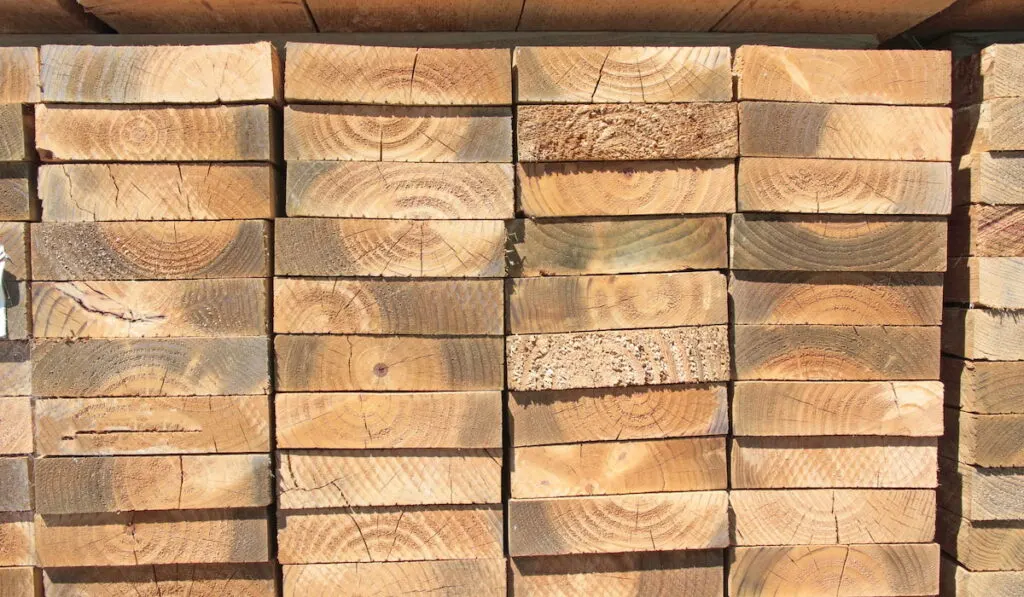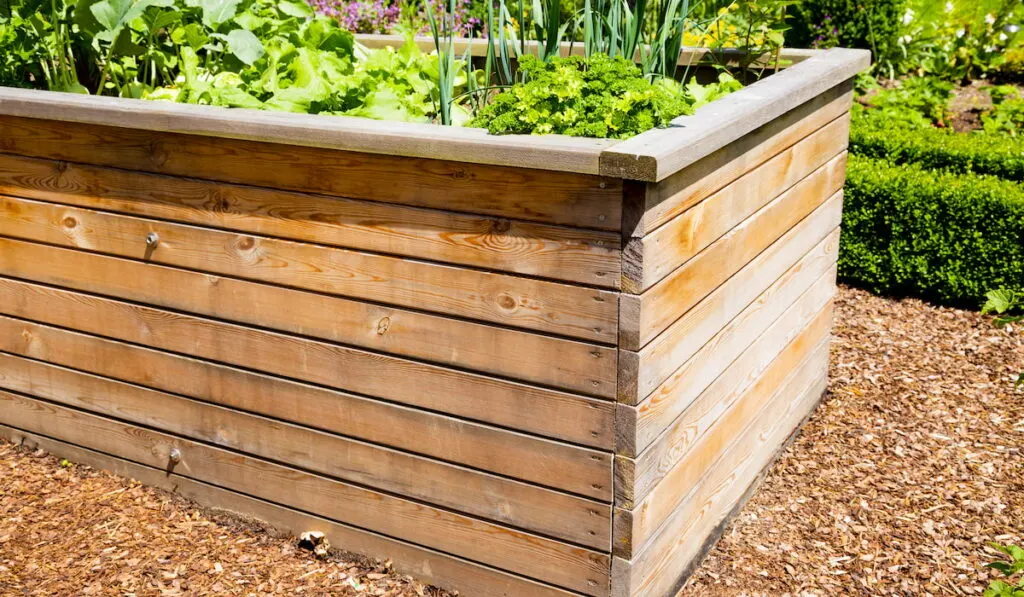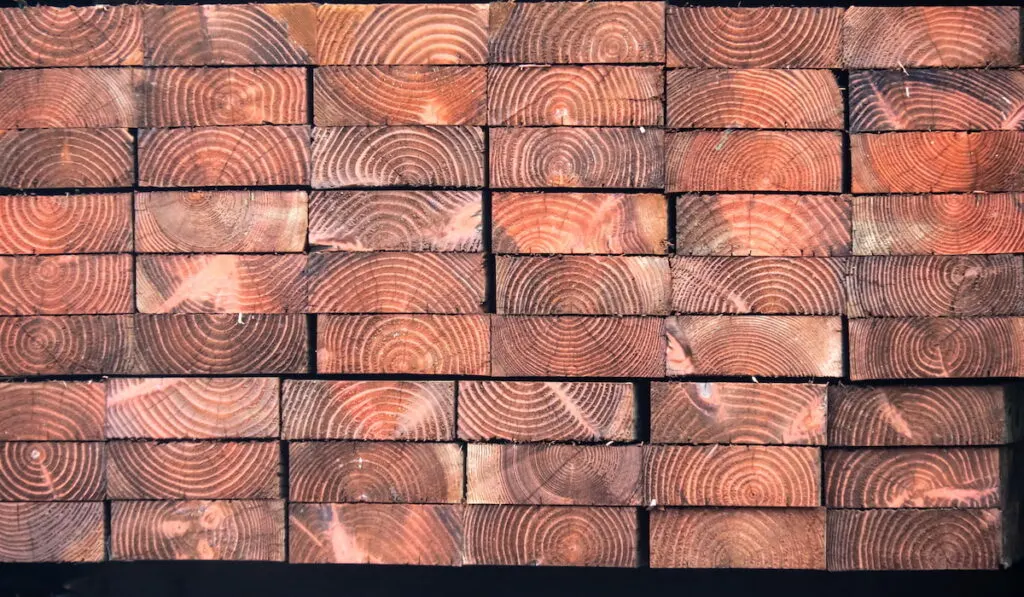So you have finally decided to undertake the process of building your raised bed gardens but, now you have to decide on the materials for your project. When it comes to wood, you have many options available. For most wood projects where the lumber is in contact with the soil, treated lumber is the best option due to it’s ability to resist rot. But, is that true with raised garden beds?
You can use treated lumber to build your raised garden beds. Most people who intend to grow edible plants in their garden, such as vegetables, opt to line the raised bed with plastic.

When using treated lumber, lining your raised garden bed can put your mind at ease that chemicals will not be leaching into the plants that you eat.
In order to make the decision that is right for you and your family, it helps to know a little bit more about treated lumber and how it might impact the soil.
Table of Contents
What Is Treated Lumber?
Treated lumber is wood that has been well treated with chemical preservatives. These preservatives help in prolonging the intended use of the wood as compared to the untreated wood.
There are several preservatives used to protect lumber from fungal decay, termites, water organisms and structural degradation.
How Safe Is Pressure Treated Lumber?

Pressure-treated lumber is very safe if a number of factors are put into consideration. These include;
Planting the crops away from the pressure-treated wood walls to prevent leaching the chemicals into soil.
Applying a sealer to protect exposure to CCA. Oil can be used as a sealer. This offers protection from stains and to humans.
Is It Safe for Growing Food?
Despite the fact that pressure-treated timber is safe, it is not recommended for use in gardens meant to grow food crops. However, it can be used when an impermeable liner is placed between the wood and the soil.
The following steps are followed to reduce exposure of food crops to the pressure-treated wood.
The crops should be planted away from the walls of the garden beds. This will prevent the preservative from leaching into the soil.
Use plastic sheets to line the garden beds. They create an impervious barrier between the plant roots and the pressure-treated timber.
For extra safety, peel root crops before consuming. This is because roots more copper than any other plant part. Peeling helps remove copper traces.

Do Plants Absorb the Preservative in Pressure Treated Wood Raised Garden Frames?
Plant roots are capable of absorbing these preservatives. However, studies show that the amounts leached into the soils are too low to be detected.
The preservatives leached are less toxic unless they are consumed though it is advisable to wash all root crops before consuming.
Should Pressure-Treated Lumber Be Used in a Vegetable Garden?
Yes! Pressure-treated wood is safe for vegetable garden beds but with some precautions.
- The crops should be grown 10 inches away from CCA treated woods to prevent leaching of the chemicals into the plants.
- Heavy impermeable plastics can also be used to act as a barrier between the crops and the wood.
How to Safely Use Treated Wood Near Vegetable Crops
In order to ensure there is no leaching of the preservatives into the soil, the following precautions are taken:
Predrill nail holes that are less than an inch to the wood. This will reduce the probability of having the wood split during the tightening process.
If the wood does not split when predrilled, the chances of splitting later are high since the wood dries up. After drilling, ensure you remove all the sawdust.
Correct fasteners must be used. Use galvanized screws or nails designed only to be used with the pressure-treated lumber.
Be sure to buy the correct type of pressure-treated wood for your garden. Use ground-contact pressure-treated woods if you want them to last longer.
Use an impervious liner between the soil and the woods.

What Can Be Done to Reduce the Risks of Garden Uses of CCA-Treated Wood?
Although the potential risks associated with CCA treated woods are minimal, the following precautions can be followed to ensure there are no further risks.
Instead of using CCA treated wood, you can use alternatives such as concrete blocks, plastic lumber, bricks or stones. You can also use wood treated with ACQ (alkaline copper quaternary ammonium) which contains no toxic chromium and arsenic.
Do not allow sawdust from the CCA treated wood to leach into the garden beds if you have to use CCA woods.
Use heavy plastics to cover CCA treated wood to prevent contact with soil.
Peel your root crops such as carrots and potatoes before consuming. Peeling helps remove copper, chromium and arsenic components that may be present.
Do not plant your root crops too close to the woods where the concentrations of CCA is high. Space at least 10 inches apart.
Thoroughly wash all root crops grown in gardens where CCA pressure-treated wood is used.
What Is CCA – Treated Wood?
This is a wood preservative that contains chromium, copper and arsenic in different amounts. CCA treated wood is used to impregnate timber so as to protect them from microbial and insect attacks. It leaves a greenish tint to the treated timber.
How Do You Know If Your Wood Is CCA Treated?
Pressure-treated lumber gets a greenish colour because of the treatment process. It also has end tags and can have a chemical or oily smell as compared to untreated wood.
End Tags
An end tag or stamp has the name of the preservative that is used to treat the wood. It also contains the name of the preservation company and the rating.
CCA treated woods are associated with cancer risks hence they are banned for use in playgrounds, decks and outdoor structures in a residential setting.
The Stamps
Stamps are found on the wood. Stamps that read “L P22” designate that the wood was treated with arsenic.
Stamps that read “L P2” is not harmful but it is still not recommended for home furniture settings.
Lumber that is treated with borate causes no harm to humans and is safe for use in homes. Borate-treated lumber bear the stamp “Bor”, “Hi Bor” or “Tim Bor”.
The safest pressure-treated woods bear the stamp “FDN”.
Check the Colour
Faint olive green colour is another way of identifying a CCA treated lumber.
Borate-treated woods have a blue colour. This lumber is used to keep off termites.
Conduct a Smell Test
If your wood has no end tag, stamp or noticeable colour, you can take a deep sniff. Treated wood has an oily/ chemical smell whereas untreated wood has a nice and fresh smell. However, there are CCA treated lumbers have no identifiable smell. A wood testing kit can be used.
Use a Wood Testing Kit
Using a wood testing kit is the last option to determine if the wood is safe for garden use or should be disposed. Check the status of the lumber and follow the available instructions.
Best Woods for Raised Garden Beds
| Wood Type | Benefits |
| Cedar | It is chemical free, easily takes paint, has a fairly long lifespan and has a beautiful, smooth appearance. |
| Juniper | It has a very long lifespan, inexpensive and chemical free. Pressure treated. It is inexpensive and has a fairly long lifespan. |
| Reclaimed Wood | It is often inexpensive and can be rustic. |
| Redwood | It is chemical free with a fairly long lifespan. |
Conclusion
CCA pressure-treated woods are preservatives containing chromium, copper and arsenic. They offer protection against termites, microbial attacks and even structure-wise.
Pressure-treated woods are safe for vegetable gardens provided that precautions are followed.
Resources
- https://www.naturalhandyman.com/iip/infxtra/infptforraisedgardens.html
- https://extension.psu.edu/environmental-soil-issues-garden-use-of-treated-lumber
- https://www.treatedwood.com/learn/what-is-treated-wood
- https://en.wikipedia.org/wiki/Chromated_copper_arsenate
- https://anestwithayard.com/how-to-tell-if-wood-is-treated/
